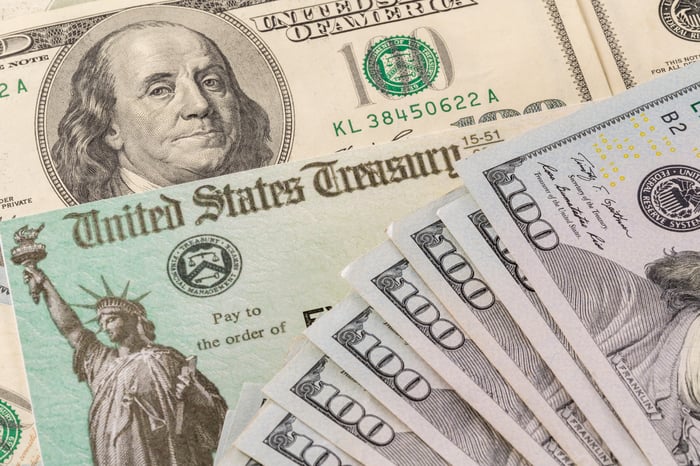Following months of discussion, lawmakers in Washington are close to passing another round of fiscal stimulus. At the time of this writing (March 3), it's unlikely to total the full $1.9 trillion that President Joe Biden called for. However, it will entail another round of stimulus checks for the American public.
Congress passed $600 stimulus checks for eligible Americans in late December, and now the expectation is that well over 100 million Americans will qualify for a $1,400 stimulus check. For many, this cash will help them cover their rent or mortgage, utility bills, or other pressing needs.
But for people who've been relatively unaffected by the coronavirus pandemic and who have hearty emergency funds, this $1,400 stimulus check could be the perfect excuse to put that money to work in the stock market. After all, the S&P 500 has doubled investors' money, inclusive of dividend reinvestment, about once every seven years since 1980.
But you can probably do better than a 100% gain this decade. If you buy innovative, high-powered stocks with your $1,400 stimulus check and demonstrate the patience to allow your thesis to come to fruition, the following three stocks could turn that $1,400 check into $10,000 (or more).

Image source: Getty Images.
Fastly
One supercharged growth stock that has the potential to double investors' stimulus checks many times over is cloud edge services provider Fastly (FSLY 1.27%).
In simple terms, Fastly is tasked with safely and securely expediting the delivery of content to end users. Since it's a usage-based operating model, it's important for Fastly to be scalable with existing clients, as well as be appealing enough to draw in new customers.
During the fourth quarter, the company reported a dollar-based net expansion rate (DBNER) of 143%, which was down only slightly from a DBNER of 147% in Q3 2020. In layman's terms, this figure means existing clients spent a respective 43% and 47% more in Q4 and Q3 than they did in the prior-year period. Fastly's total customer count also rose by 37 to 2,084.
The good news for buyers is that Wall Street hasn't been thrilled with Fastly of late, which means it's on sale. Total customer growth slowed quite a bit in Q4 (albeit one quarter doesn't make a trend), and the company lost traffic from its top customer TikTok in the third quarter. The loss of TikTok's traffic had to do with parent ByteDance locked into a stateside spat with the Trump administration. In other words, it wasn't Fastly's fault.
The expectation is that we'll see edge cloud demand ramp up throughout the decade as businesses and consumers push online and into the cloud. Wall Street's current expectation is for Fastly to nearly triple sales by 2024 to $850 million, with its growth rate likely maintaining a 30% (or higher) level for much of the 2020s. With a reasonably low market cap of less than $8 billion, it looks to offer serious upside to patient investors.

Image source: Getty Images.
Ping Identity
Another growth stock that's a bit unloved of late but has plenty of long-term upside is cybersecurity stock Ping Identity (PING).
To build off what was discussed with Fastly, businesses are rapidly moving to an online and cloud-based presence. That means the onus of protecting company and customer information is falling into the laps of third-party providers on a regular basis. And since hackers don't take time off, cybersecurity has evolved into a basic-need service.
Ping Identity's specialty is (as the name implies) identity verification. Aside from well-known solutions, such as two-factor authentication to weed out threats, Ping's cloud-native approach leans on artificial intelligence and machine learning to grow smarter over time. The better Ping's solutions are at identifying threats, the more nimble it can be in responding to them.
The biggest issue for the company in 2020 was the decline in multiyear subscriptions and the uptick in one-year subscriptions. While this isn't a surprise, given the record-breaking uncertainty caused by the pandemic, it's slowed growth temporarily and caused customer-churn concerns to arise.
The good news is that Ping Identity has had no issue attracting larger businesses. The company claims 60% of the Fortune 100 as customers, with 51 of its clients generating over $1 million in annual recurring revenue (ARR). That's up from 38 customers with an ARR over $1 million in 2019.
Finally, keep in mind that over 90% of Ping's revenue is derived from subscriptions, and the company's subscription gross margin is a beautiful 86%. There's plenty of wiggle room in the wake of a pandemic when you're dealing with margins this high. Look for Ping to deliver in a big way for investors this decade.

Image source: Square.
Square
Fintech stock Square (XYZ 5.42%) is a third high-powered company with all the tools needed to double investors' $1,400 stimulus check many times over by 2030.
Square is probably best-known by folks as a payment facilitator. Its point-of-sale card-reading devices are used by businesses of all sizes. Between 2012 and 2020, the gross payment volume (GPV) that's traversed Square's network has catapulted from $6.5 billion to north of $112 billion last year. Take out the coronavirus-impacted 2020, and Square's seller ecosystem grew GPV by an average of 49% annually over the previous seven years.
Since the seller ecosystem is a merchant fee-driven segment, it's especially exciting to learn that bigger businesses (as measured by annualized GPV) are adopting the platform. In the fourth quarter, 60% of total GPV was derived from businesses with an annualized GPV over $125,000. That's up 8 percentage points from the same period in 2018.
However, the greatest growth driver for Square is likely to be its peer-to-peer payment platform Cash App. In three years, Cash App's monthly active user count has more than quintupled from 7 million to 36 million. This is a segment that allows Square to generate revenue from merchant fees, bank transfers, investments, and Bitcoin exchange. In fact, Bitcoin revenue tallied $4.57 billion last year, which was nine times higher than in 2019.
Maybe the craziest metric of all -- and the sign that Square holds the potential to be a 10-bagger this decade -- is that the cost to acquire Cash App customers was less than $5 in Q4 2020, yet gross profit per monthly active user rose 70% to $41. That's insanely profitable and demonstrates the incredible engagement users have with Cash App.





